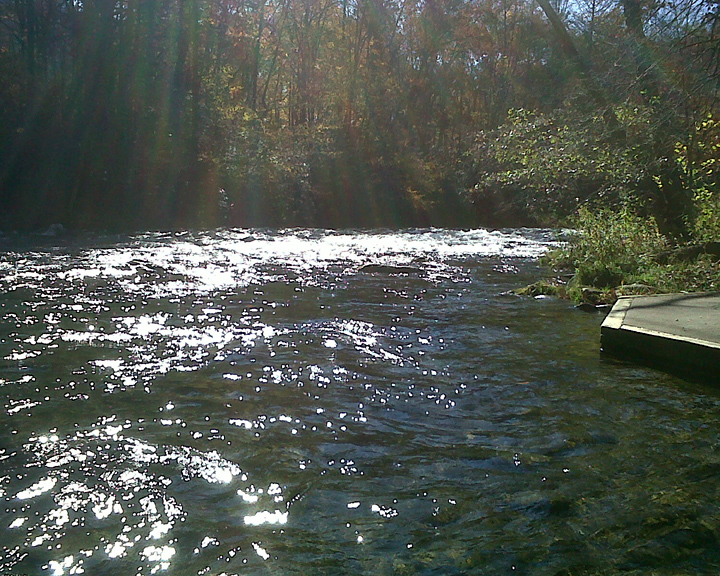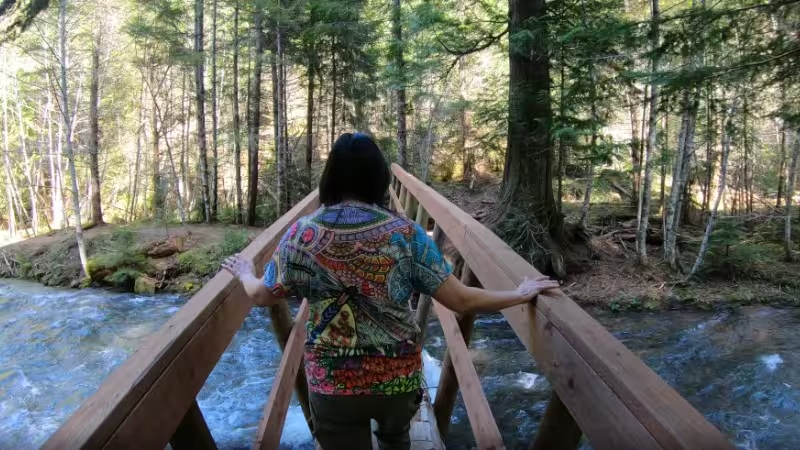Thought streams can impact one’s ability to cross the First Threshold. Setting out on the path by Crossing the First Threshold means being open to new ways of thinking and new ways of being. One way to do this is to change your thoughts by learning to live in the present moment, with intention.
Imagine that your thought streams and feelings are like a river. The river is always flowing, ever changing. In this river of the mind, sometimes positive thoughts float to the top, and sometimes negative thoughts float to the top. If we find ourselves in a spot on the river where those negative thoughts are floating to the top, our goal isn’t to stop the river by trying to dam it up. If we try to dam up the river, the water will only continue to back up behind the dam until either the dam bursts or the water overflows.
This is what happens when people have panic attacks or “nervous breakdowns.” The water behind the dam has no place to go, and it eventually builds up until a catastrophe happens.
Trying to stop negative thought streams and feelings by damming up the river isn’t the answer, since it could lead to catastrophe. So how do we deal with such thoughts?
What if there was an alternative to trying to stop the river by building a dam across it?
Thought Streams and the River
If we find ourselves at a place on the river where those negative thought streams are flowing to the top, we can consciously decide not to drown in the river by choosing instead to get out of the river, sit on the riverbank, and watch those thoughts and feelings flow by.
When we make this choice, the river is still flowing. We haven’t tried to dam it up. We’re just not swimming in it. From our viewpoint on the banks of the river, we can watch those thoughts and feelings flow by without being carried downstream. Using our intentional powers of observing and describing our own internal states, we can acknowledge the river’s presence without being at the river’s mercy.
In our analogy of the river, the thing that makes it flow from Point A to Point B is the presence of time. The sage has said, “You can’t step twice on the same piece of water.” This is because the water is always changing from moment to moment.
If you have the opportunity, find a gently flowing river near you. This should be a river where the water isn’t flowing too rapidly, and where the water isn’t too deep. Remember, safety first! This should be a river you know well, and it’s best not to do this activity alone.
Once you have found your river, go out into it. Don’t go any deeper than your waist. It’s preferable to find a spot on the river where nature surrounds you. If in doubt, find a footbridge you can walk across instead of going into the river.
Now stand in the river and do a little deep breathing. Inhale and exhale deeply for at least three breaths. Ground and center yourself. You may wish to do a brief meditation before continuing.
Now call upon your own Supernatural Aid. You may call upon the archetypal energy of your spirit animal, or it may help to hold a talisman in your hands. When you are ready, contemplate the river.
This is a river of the mind. Upstream, your thought streams about the past spread out behind you. Downstream, the river flows into the future. To return to the past would involve wading upstream against the current. To visit the future would require swimming downstream with the tide.
Suppose you tried to wade upstream or swim downstream. Once you got to your new location, the past would still lie behind you upstream relative to where you are now. Likewise, the future would still lie downstream ahead of you.
No matter which direction you move, you will always find yourself right here, right now, in the river.
Imagine yourself turning now to face upstream, towards the past. You already know what lies behind you. There may be rocky shoals and rapids behind you. There may even be high waterfalls and boulders. But the fact that you are standing right now at this place and this time in the river means that you survived the journey. Regardless of what lies behind you on the river, you have made it this far. This means that you are a survivor! You have met the challenges on the river and have gotten to where you are today.
Now turn to face downstream. The thought streams in this part of the river are unknown to you. You haven’t ventured there yet. There is no way of knowing whether more rapids lie ahead, or whether there is smooth sailing for the rest of the journey. You might try to make educated guesses as to what the downstream journey might be, based on the parts of the river you have already traveled, but there is no way to know with any certainty whether or not those guesses are correct. Rivers can suddenly change, and if you spend all your time worrying about what lies downstream, you miss the moment in which you find yourself. Worrying too much about what might lie downstream takes energy away from enjoying the pleasant experience of the river here and now.
Even if the worst happens, and we encounter catastrophes downstream, the choice to remain in the river is still ours. We can, at any time, make the conscious choice to step outside of the river for a while to watch it flow by.
We can’t know what lies downstream, but we can prepare ourselves for it. We can’t change the river, but we can change ourselves in order to increase the likelihood of a safe journey.
Life is like a river. When we learn to go with the flow, we decrease our chances of running aground.
Now cultivate an open and accepting attitude towards everything you are experiencing. What do you see? What do you hear? Can you feel the river’s currents with your body? Are there pleasant aromas on the breeze? Enjoy the experience of being in the river right here, and right now.
When you feel at peace with your surroundings, take a mental snapshot of all you have experienced here in the river. Mentally record the river in as much detail as possible. When you have done so, you may recall and retrieve this experience the next time you are feeling stressed out.
When you are ready, leave the river and sit on the riverbank while thinking over these questions:
- Once you were grounded and centered, did you find yourself thinking about what lies upstream or what lies downstream, or neither?
- Once you were grounded and centered, did you find your mind wandering to your mental “to do” list of daily activities, or did your thought streams subside?
- What was it about the river that made this experience different than your day-to-day life?
- Is there a way to carry this experience with you into your day-to-day life?
- How might this experience help you to see things in new ways that will lead you to your True Self?
- How might this teaching metaphor help you to cross the first threshold on your own Call to Adventure?
Though Streams and the First Threshold

So, here we are, in the middle of the river. On one riverbank is the life we are leaving behind. On that other, unknown shore is the new life we’re moving towards. Crossing this river of the mind is consciously making the spiritual quest that is the Way of the Coyote the first and foremost quest in our lives. Rather than making pleasures of the flesh and accumulating material goods our goal and ambition in life is seeking a higher calling.
Seeking True Self doesn’t mean that we’re leaving our loved ones behind. It’s just the opposite. The more we are able to live according to our own true nature, the more we are able to help others. This is because when we are able to be the person we were born to be, we set aside the obligations that others have placed on us against our will. When we learn to do this, we learn to act for others because it is what we have chosen to do for ourselves, and not out of a sense of guilt, or shame, or self-blaming. This frees us to fully act for others of our own free will and to set aside resentments.
As we cross the river into the realm of the shaman, it’s not that we are leaving the material world behind either. We are instead learning a new way of seeing and being in the world. That way of seeing shows us that there is more to life than the trinkets and baubles of material possessions and status symbols. It is the path of true wealth that leads to love, connection, and ecospirituality.
This phase of the quest that is the Way of the Coyote involves emptying your cup. In order to be reborn as a seer, one must leave behind the former life. This means setting aside a life of pursuing material wealth just for the sake of owning things and instead seeking a life that makes room for nature and the spirit.
It’s very easy to get caught up in the idea that material things are the key to happiness, and a certain amount of material goods are necessary to survive. But if that is the sole motivation for life, our lives become meaningless and empty. The vision seeker instead searches for, and finds, things of spiritual significance. These spiritual things guide and enhance the quest. It is the path of true success and personal power.
Crossing the First Threshold, or crossing the river, involves announcing to the world and to yourself that the old ways have passed away. From this moment on, now and forever, a new journey begins. By announcing your intent to yourself and to others, you hold yourself accountable to staying on the path until the journey’s end. It is an acknowledgement that things will never again be as they were before.
Are you ready?
Share Your Thoughts!
What do you think? Let us know in the comments below!

